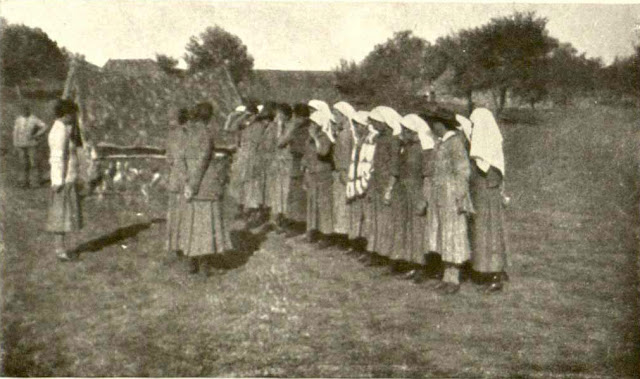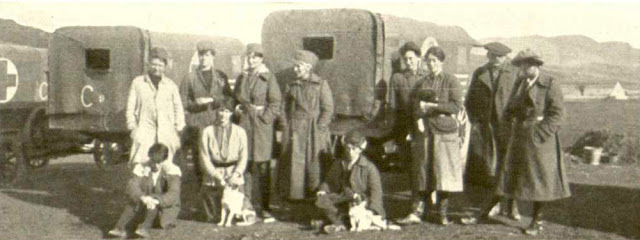Women of the Sixth (American) Unit of the Scottish Women's Hospital at Ostrovo (Wikipedia.org)
The Scottish Women’s Hospitals was founded by the surgeon and suffragette Dr. Elsie Maud Inglis (16 August 1864 – 26 November 1917), after the outbreak of World War I. Elsie Inglis and fellow suffragists, with the financial support of the National Union of Women’s Suffrage Societies, formed the ‘Scottish Women’s Hospitals Committee’.
Portrait of Dr. Elsie Maud Inglis (catalogue.wellcomelibrary.org)
At first, Inglis offered her service as surgeon to the British army, but she was told “go home and sit still woman”. In that time nurses and orderlies were permitted to serve in the British Red Cross but women doctors, were not considered competent enough. However, this did not deter Dr. Inglis who later formed the Scottish Women's Hospital (SWH), an all-woman medical organisation that would tend to the wounded of the allied nations, and give testament to the skills and professionalism of women medical practitioners.
The Scottish Women's Hospital was formed in 1914 in Edinburgh, the capital of Scotland, and by November the first medical unit was already set with state of the art equipment. With the help of the French Red Cross, a mobile hospital unit was set in Royaumont, France. The complete staff of the unit consisted of women - doctors, nurses, orderlies, cooks and even the ambulance drivers. The unit in Royaumont, France proved to be a successful one and it served in France until the end of the war.
The Kingdom of Serbia since the beginning of the First World War, requested medical and other assistance, from the International Committee of the Red Cross in Geneva. Under the impression of the situation in Serbia, Dr. Inglis, offered the Serbian mission to London to send SWH units to the Serbian battlefield, and the Serbian government accepted this offer with gratitude.
The organized work of the Association of Scottish Women's Societies in the Kingdom of Serbia began, on Christmas 1915. Soon after medical missions and well-equipped hospitals arrived in Serbia, and in 1915 there were four large hospitals of the Association of Scottish Women's Associations in Kragujevac, Valjevo, Lazarevac, Mladenovac and two large English-Serbian hospitals in Kragujevac and Skopje.
Attacked by Austro-Hungary, the conditions in Serbia were terrible with many victims, wounded soldiers and prisoners of war, starved civilian population and major typhus epidemic in 1914/1915. Many perished in the first years of the war, including several members of SWH.
When the great offensive of the Central Powers began in October 1915 (Bulgaria joined on the side of the Central Powers and attacked Serbia), all hospitals were evacuated to Krusevac, and later some retreated together with the Serbian army trough Albania.
Dr. Inglis and the majority of her staff refused to evacuate and stayed with their patients in occupied Serbia, becoming prisoners of war in November, 1915. They continued to treat their patients until their repatriation in February, 1916.
One part of SWH followed the Serbian army, which after its reorganization was sent on the newly formed Macedonian Front in 1916. Dr. Inglis, returned to England, formed another SWH unit and went to Russia, again to aid the Serbian army on Dobrudja front. After the Bolshevik revolution, she returned to Newcastle, England, where she died of cancer one day after her arrival.
 |
| Dr. Elsie Maud Inglis (left) (source of photo: Ратни албум 1914-1918, Поповић, Андра, Београд, 1926) |
SWH on the Macedonian front (Salonika Front, Thessaloniki Front)
By the end of 1915, Serbia was attacked from all sides. The government, together with what remained of the army and part of the civilian population, retreated through Albania to the island of Corfu, Greece. On this island was the new headquarters of the government and began the reorganization of the army, which in 1916 was sent to the newly formed front near Salonica (Thessaloniki). Aldo Greece was still neutral, around Salonica there were Allied fortifications protecting the city and the port from the Central Powers. Hence, in some sources this front is called Salonika or Thessaloniki Front.With the arrival of the reorganized Serbian army and the reinforcements from France, England, Italy and Russia, the front line was considerably expanded, reaching the Aegean Sea to the east and the Adriatic to the west, across the ethnic region of Macedonia – ie Macedonian Front.
At the end of 1915 the Scottish Women's Hospital unit at Troyes, France was ordered to pack. Designed as a mobile unit, it was equipped with tents and vehicles, and attached to a division of the French army, it was dispatched to Salonica. The hospital (known as the Girton & Newnham Unit after the Cambridge University colleges which funded it) first was set up in a silkworm factory in the border town of Gevgelia, and after the rapid Bulgarian advance is was relocated to Salonica.
 |
| SWH unit on the Macedonian front (source of photo: Ратни албум 1914-1918, Поповић, Андра, Београд, 1926) |
In Salonika the unit was joined by the American Unit (funded by American donors and named as to thank them), and both later were moved to Lake Ostrovo, where they supported the Serbian Army.
The SWH had hospitals and a transport unit on the Macedonian Front. Medical missions from other parts of the Commonwealth came from: Australia, New Zealand and Canada. A total of 60 women arrived, serving as nurses, ambulance drivers, doctors and surgeons. They were well equipped with vehicles with which they transported wounded soldiers from the Macedonian mountains (Transport Column). The Transport Column was an ambulance unit which allowed SWH to go and get the casualties quickly rather than waiting for casualties to be brought to them.
“Amongst the SWH staff was also Stella Maria Sarah Miles Franklin (Miles Franklin), a famous Australian writer”
Transport Column - Scottish Women`s Hospitals Motor Ambulance Column
 |
| Scottish Women’s Hospitals ambulance drivers on the Macedonian Front (source of photo: Australian War Memorial Collection) |
“At first the Transport Column unit was commanded by Katherine Harley, who died during the bombardment of Bitola on March 7th, 1917.”
 |
| Katherine Harley with the Transport unit in Thessaloniki (source of photo: Ратни албум 1914-1918, Поповић, Андра, Београд, 1926) |
After the end of the First World War, SWH was disbanded. Most of its members returned to their home countries, while some continued to deal with humanitarian activities in Serbia. Dr Kathleen McPhail in Belgrade established a children hospital and Evelina Haverfield with Vera Holme established an orphanage in Bajina Bašta. Others, left endowments in money and equipment, educated pupils, and provided scholarships for women doctors.
More info on Scottish Women's Hospital:
- https://www.scottishwomenshospitals.co.uk
- https://debbierobson.net/australians-working-with-the-scottish-womens-hospitals/#Bsurname







0 Comments